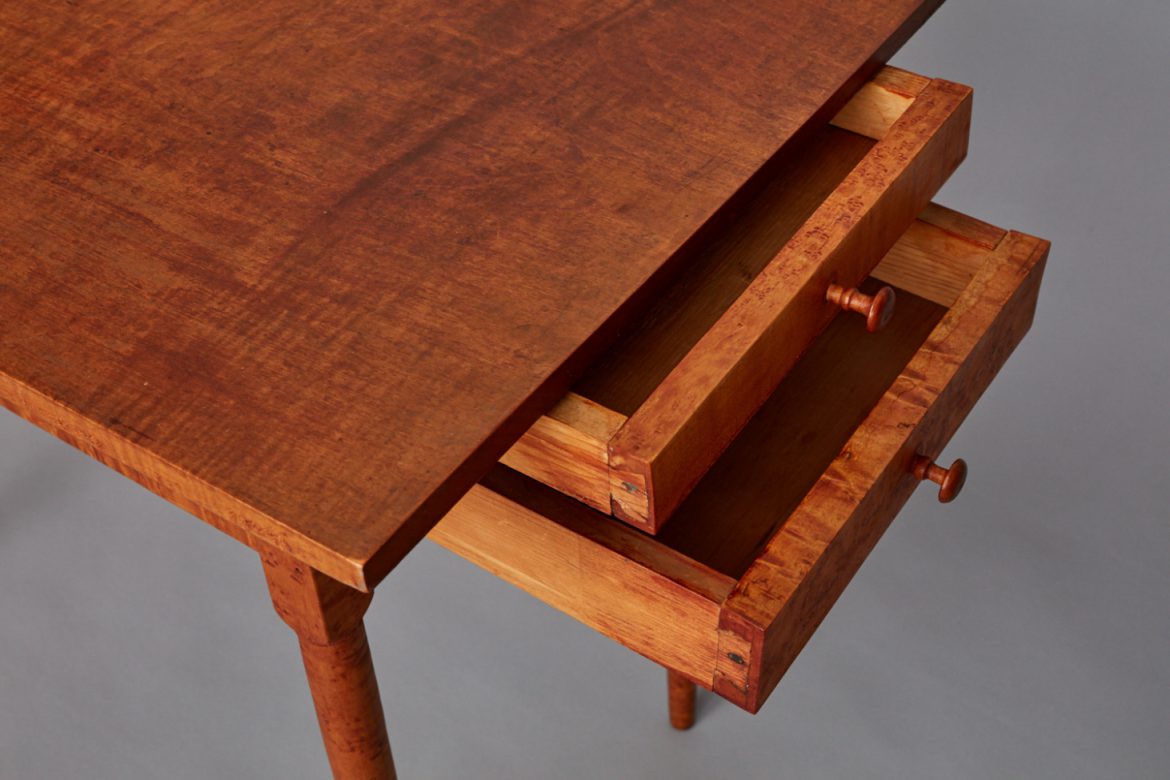
It's all in the details: Identifying the community of origin for Shaker furniture
At the Spring Shaker Forum held at Enfield (NH) Shaker Village this April, Robert P. Emlen presented an illustrated lecture on a design detail associated with Shaker woodworkers from that community: a small ring made by wood-turners at the transition point between a square piece of wood and where it becomes round (figure 1 below). There are any number of ways to handle this transition, […]
At the Spring Shaker Forum held at Enfield (NH) Shaker Village this April, Robert P. Emlen presented an illustrated lecture on a design detail associated with Shaker woodworkers from that community: a small ring made by wood-turners at the transition point between a square piece of wood and where it becomes round (figure 1 below). There are any number of ways to handle this transition, from the abrupt change shown in figure 2, to merely creating a rounded shoulder on the corners of the square as in figure 3, or in some cases Shaker turners even took a more decorative approach as demonstrated in figure 4, a table made late in the nineteenth century by Elder Henry C. Blinn at Canterbury. The decision about how to make this transition was likely left up to the turner, but once a method for making the transition was used it was likely to become a trademark of that turner and a model to be copied by apprentices. While it is not possible to associate this detail with a particular woodworker, it is possible to use it to begin to identify in which Shaker community a piece was made.

Fig. 1 Side Table, (detail of transitional ring), Enfield, NH, Ca. 1850, Shaker Museum | Mount Lebanon: 1954.6954.1. John Mulligan, photographer.

Fig. 2 Side Table (detail of turning transition), Canterbury, NH, Ca. 1850s, Shaker Museum | Mount Lebanon: 1972.17507.1

Fig. 4 Table (detail of turning transition), Church Family, Canterbury, NH, Ca. 1880s, Shaker Museum | Mount Lebanon: 1950.531.1. Staff photograph.

Fig. 2 Side Table (detail of turning transition), Canterbury, NH, Ca. 1850s, Shaker Museum | Mount Lebanon: 1972.17507.1
Emlen pointed out that the detail shows up on documented Enfield table legs, bed legs, work desks, and even on newel posts in the Great Stone Dwelling. The three-drawer side table in the Shaker Museum | Mount Lebanon collection provides a good example of this design detail. It was acquired by the Museum in 1954 directly from the Shakers at Canterbury and identified at the time as the work of a Canterbury cabinetmaker. We now assume the table was, in fact, made at Enfield and brought to Canterbury when the Enfield community closed in 1918. By 1954 its journey to Canterbury was probably long forgotten. While this is a perfectly logical explanation for the discrepancy between the design detail and its assumed origin, it does offer an opportunity to take a look at the complexity of identifying the origin of a piece of Shaker furniture. If a piece lacks a pencil, pen, or crayon inscription stating that it was made by a particular Shaker, at a particular Shaker community, on a particular date, there are several possibilities that might explain an apparent disparity between where a piece of furniture appears to have been made and where it was found.

Side Table, Enfield, NH, Ca. 1850, Shaker Museum | Mount Lebanon: 1954.6954.1. John Mulligan, photographer.
Some cabinetmakers are known to have moved either temporarily or permanently from one community to another. They likely worked at their new home in the style they had originally learned. This is probably the case with Brother Samuel Turner, who began his Shaker life at Mount Lebanon, moved to Pleasant Hill, Kentucky, and later returned to Mount Lebanon, where he died. Furniture he made after his return to Mount Lebanon shows some influence from his three decades of life in Kentucky. Members of the Shaker ministry who worked as cabinetmakers moved among the communities in their bishopric and often maintained workshops at each village. Elder Giles Avery at Mount Lebanon is thought to have made work desks while at his workshop – most likely Elder Freegift Wells’s workshop – and probably made work desks at Lebanon as well. This movement of the ministry from place to place might explain some of the confusion in identifying differences between furniture made at Hancock, Massachusetts, and some that is thought to have been made at Enfield, Connecticut. A third possibility is that cabinetmakers made furniture that was intended to be sent to another community. This might happen following a fire or other devastating event that put a community in need of more furnishings than it could easily supply.
This little discrepancy between where the three-drawer side table was acquired and where it was probably made how difficult it can be to positively identify where a piece of furniture was made, let alone who might have made it.